“Stories Untold,” a screening of experimental films, drew a mix of curious students, film majors, and Boulderites with its unusual and offbeat manner.
The Monday night screening was part of First Person Cinema, a long-standing series devoted to experimental cinema. The films were prefaced by a brief talk by Bay Area curator Steve Seid.
The series fits easily into the Boulder art scene with a mix of surrealism, humor, and thought-provoking themes. The screening featured seven experimental films, which spanned several decades. Before the screening began, Seid described the films as a very nice way of looking at ways of undoing stories.
The first film “The Bed” by James Broughton, fit a stereotypical expectation of experimental cinema. Naked locals, costumes, and whimsical music were abundant in the short film.

A still from "All Smiles and Sadness," a black and white film by Anne McGuire. (Courtesy of Video Data Bank)
The dreamlike quality added to the various scenes, which ranged from a man putting on a pair of boots before getting in bed to a woman reading a bedtime story to a dog. The film flips through birth, death, and many of the phases in between, cramming many different themes into about twenty minutes.
Curt McDowell’s “A Visit to Indiana” is in stark contrast to Broughton’s film. The film chronicled a trip home to the Midwest to visit his family and focused on McDowell’s disillusionment of returning to Indiana, where things are static and very different than the explosive Bay Area.
McDowell and a friend discussed his family over images of Indiana, from car rides to family gatherings. It felt like watching an old home movie, but the narration was comical and intentional.
When asked about his father’s hobbies, McDowell replied, “He likes being a good father; and welding; and eating.” The film focused on the mediocrity of the Midwest, taking the viewer through McDowell’s eyes, and is one of the most entertaining films of the series.
Before the start of “A Reason to Live” by George Kuchar, Seid describes Kuchar as a large influence on his students and a “classic experimental film maker when you talk about budget because [he had] no budget.”
The film is the only one in the series to follow a storyline the way a normal short film would, although many of the events are jumbled and confusing. The characters are overdramatic, but it seems ironic and intentional.
Weather is used as a metaphor for what Seid describes as the libido of the larger universe, and appropriately, the main character chases bad weather and then dies in a tornado. The visual aspect of the film, the audio, and the dialogue match and meld well to create a somewhat somber, but also caustic tone.
“Deadline” by Max Almy is the most experimental film of the entire series. A woman spewing encouraging mantras plays over a growing and shifting image of a running man. The mantras loop, and with each iteration, the tone changes.
The second iteration is faster and more frantic, as an image of the woman’s lips plays behind the running man. The last time, the lips are back, but the images are stylized and distorted and the voice seems angry. Although the film seems simple, it drives the message of performing under pressure home.
Seid prefaces Chip Lord’s “Easy Living” by clarifying it as a reaction to “Deadline.” It is completely different from the previous film. Before it begins, Seid summarizes, the film is about the suburbs’ ominous monotony. The film was created using miniatures and toys, and “Easy Living” relies on the sound and the minimal movements in each scene.
It scans through many different situations, from getting one’s car washed to going to the drive in. The slight movements of the toy people and the repetition of the scenes create an impersonal vibe, building the idea of ominous monotony. The film drags on, and although interesting, it feels too long, which might have actually been the point.
Scott Stark is the creator of the next film, “I’ll Walk with God.” Seid described Stark as driven by curiosity, which came across as a warning that the film is going to be pretty different technically than the previous films.
“I’ll Walk with God” is a compilation of images from the emergency instructional pamphlets found in airplane seat back pockets. The film is silent until the end when Stark inserts a song over the images, creating a striking and powerful contrast. A strobe effect with both images and a blank screen helped develop the film and keeps the audience’s attention.
The last film, “All Smiles and Sadness” by Anne McGuire, described by Seid as a collapsed soap opera. The film is very simple. It has a dark black background with leaves to distract the viewer from the actors. The characters speak in verses about love and life that seem equally poetic and insane.
The film came across like a bad high school performance, but it went on this seemed more like that that was intentional.
Almost all of the films included some kind of humor, and most of them hit home and forced the viewers to relate—even if they weren’t sure what exactly they were responding to. With Steve Seid’s input and commentary, “Stories Untold” provided viewers with a new understanding of experimental film and the history behind it.
Contact CU Independent Staff Writer Ainslee Mac Naughton at Ainslee.macnaughton@colorado.edu.
